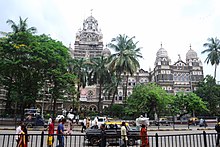Western Railway zone
 Western Railway-9 | |
| Overview | |
|---|---|
| Headquarters | Churchgate, Mumbai |
| Locale | Maharashtra, Gujarat, Rajasthan, Madhya Pradesh |
| Dates of operation | 1951-present– |
| Predecessor | Bombay, Baroda, and Central India Railway (BB&CI), and the Saurashtra Railway, Rajputana Railway and Jaipur State Railway |
| Technical | |
| Track gauge | broad gauge, meter gauge |
| Other | |
| Website | WR official website |


The Western Railway is one of the 17 zones of Indian Railways, and is among the busiest railway networks in India. The major railway routes of Indian Railways which come under Western Railways are: Ratlam - Mumbai Central, Surat - Mumbai, Surat - Ahmedabad, Ahmedabad - Vadodara and Palanpur - Ahmedabad. The railway system is divided into six operating divisions: Vadodara, Ahmedabad, Rajkot, Bhavnagar, Ratlam and Mumbai.Ratlam has emerged as the growing division for western railways.Vadodara railway station is the busiest junction station in western railways and one of the busiest junctions of indian railways too.
History
The Western Railway was created on November 5, 1951 by the merger of several state-owned railways, including the Bombay, Baroda, and Central India Railway (BB&CI), and the Saurashtra Railway, Rajputana Railway and Jaipur State Railway. The narrow gauge lines of Cutch State Railway was also merged into it in 1951.
The BB&CI Railway was itself inaugurated in 1855, starting with the construction of a 29-mile (47-km) broad gauge track from Ankleshwar to Utran in Gujarat state on the west coast. In 1864, the railway was extended to Mumbai.
Subsequently, the project was further extended beyond Vadodara in a north easterly direction towards Godhra, Ratlam, Nagda and thereafter northwards towards Kota and Mathura, to eventually link with the Great Indian Peninsular Railway, now the Central Railway, which had already started operating in Mumbai in 1853. In 1883, a metre gauge railway system, initially linking Delhi with Agra, Jaipur and Ajmer, was established.
The first suburban service in Mumbai with steam traction was introduced in April 1867. It was extended to Churchgate in 1870. By 1900 45 trains in each direction were carrying over one million passengers annually.
The railways of several princely states were also integrated into the Western Railway. The Gaekwars of Baroda built the Gaekwar's Baroda State Railway (GBSR), which was merged into the BB&CI in 1949. Several railways of western Gujarat, including the Bhavnagar, Kathiawar, Jamnagar & Dwarka, Gondal, and Morvi railways were merged into the Saurashtra Railway in 1948. The Jodhpur and Bikaner Railway was taken over by Rajasthan state in 1949, after the western portion was ceded to the government of Pakistan.
In 2002, the Jaipur and Ajmer divisions of the Western Railway became part of the newly-created North Western Railway, and in April 2003 the Kota division of the Western Railway became part of the newly-created West Central Railway.
Serial Blasts in Mumbai Locals
On July 11, 2006, the Western Railway was a target of terrorist attacks. Seven explosions occurred during rush hour (6-7pm) killing 190 and injuring more than 300 people. The blasts occurred at various stations including Bhayandar, Khar, Matunga, Mahim, Jogeshwari and Borivali. Only the first-class compartments of the trains were targeted.
Present

Western Railway headquarters in Mumbai's Churchgate station and serves the entire state of Gujarat, some portions of Western Madhya Pradesh, and coastal Maharashtra. The Western coast of India served by Western Railway has a number of ports, most important among them being Kandla, Hajira, Surat, Okha, Porbandar, Bhavnagar in Gujarat state and Mumbai in Maharashtra. Electric Multiple Units (EMUs) ply between Churchgate and Virar (64 km) and is projected to extend the service till Dahanu Road, while Mainline Electrical Multiple Units (MEMUs) service the section beyond Virar till Dahanu Road (60 km). EMUs are of 9 car, 12 car or 15 car rakes and are differentiated as slow and fast locals. Slow trains halt at all stations, while fast ones halt at important stations only and are preferable over longer distances. The first electric train on this section was introduced in 1928 between Churchgate and Borivali.
The gauge-wise kilometrage of Western Railways at present, is as under:
| Gauge | Length |
|---|---|
| Broad Gauge | 4,305 km |
| Metre Gauge | 4,838 km |
| Narrow Gauge | 877 km |
| Total | 10,020 km |
Western Line
The Western Railway has its headquarters at Churchgate in Mumbai. It also operates the Western Line of the Mumbai suburban railway system. Ratlam, which is the next big junction is 700km away from Mumbai
Major Stations
Churchgate, Mumbai Central, Ahmedabad Junction, Bandra Terminus, Vadodara junction, Surat, Valsad, Bhavnagar Terminus, Ratlam Junction, Indore Junction, Ujjain Junction, Rajkot junction, Gandhidham
External links
